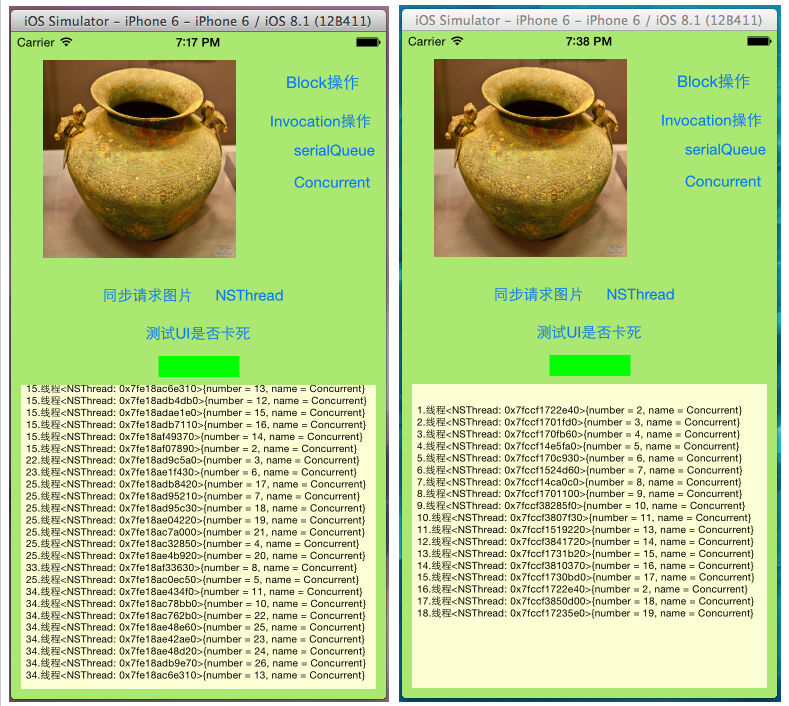iOS开发之多线程技术(NSThread、OperationQueue、GCD)
在前面的博客中如果用到了异步请求的话,也是用到的第三方的东西,没有正儿八经的用过iOS中多线程的东西。其实多线程的东西还是蛮重要的,如果对于之前学过操作系统的小伙伴来说,理解多线程的东西还是比较容易的,今天就做一个小的demo来详细的了解一下iOS中的多线程的东西。可能下面的东西会比较枯燥,但还是比较实用的。
多线程用的还是比较多的,废话少说了,下面的两张截图是今天我们实验的最终结果,应该是比较全的,小伙伴们由图来分析具体的功能吧:

功能说明:
1、点击同步请求图片,观察整个UI界面的变化,并点击测试按钮,红色是否会变成绿色。
2、NSThread按钮,是由NSThread方式创建线程并执行相应的操作。
3、Block操作按钮是用Block创建操作,并在操作队列中执行,下面的是Invocation操作
4、serial是GCD中的串行队列,concurrent是GCD中的并行队列
好啦,上面的咸蛋先到这儿,代码该走起啦。
一、准备阶段
1.不管使用代码写,还是storyboard或者xib等,先把上面所需的控件初始化好以便使用
2.点击测试UI按钮,改变下边label的颜色的代码如下:
1 //改变lable的颜色,在红绿颜色之间进行交换 2 - (IBAction)tapTestButton:(id)sender { 3 static int i = 1; 4 if (i == 1) { 5 _testLabel.backgroundColor = [UIColor redColor]; 6 i = 0; 7 } 8 else 9 { 10 _testLabel.backgroundColor = [UIColor greenColor]; 11 i = 1; 12 } 13 14 }
3.从网络上获取图片,并使用主线程显示进程调用情况
1 //从wang'lu获取图片数据 2 -(NSData *) getImageData 3 { 4 5 _count ++; 6 int count = _count;
//线程开始启动 7 NSString *str = [NSString stringWithFormat:@"%d.线程%@",count,[NSThread currentThread]];
NSLog(@"%@",str);
8 NSData *data; 9 [NSThread sleepForTimeInterval:0.5]; 10 data = [NSData dataWithContentsOfURL:[NSURL URLWithString:IMAGEURL]]; 11 12 NSString *str = [NSString stringWithFormat:@"%d.线程%@完毕",count,[NSThread currentThread]]; 13 //请求数据的任务由其他线程解决,所以LogTextView的内容由主线程更新,也只有主线程才能更新UI 14 [self performSelectorOnMainThread:@selector(updateTextViewWithString:) withObject:str waitUntilDone:YES]; 15 return data; 16 }
4.上面的用到了主线程来调用updateTextViewWithString方法,因为只有主线程才能更新UI,updateTextViewWithString:这个方法负责把线程的执行信息显示在View上,代码如下:
1 //在ViewController上显示图片请求情况 2 -(void)updateTextViewWithString:(NSString *)str 3 { 4 NSString *old_str = [NSString stringWithFormat:@"%@\n%@",_logTextView.text, str]; 5 6 _logTextView.text = old_str; 7 //改变Label的颜色,便于观察 8 [self tapTestButton:nil]; 9 }
5.把请求完的图片加载到ImageView上
1 //更新图片 2 -(void) updateImageWithData:(NSData *)data 3 { 4 UIImage *image = [UIImage imageWithData:data]; 5 [_testImage setImage:image]; 6 }
6.加载图片的,也就是请求数据后在ImageView上显示
1 //由其他线程请求数据,由主线程来更新UI 2 -(void)loadImageWithThreadName:(NSString *)threadName 3 { 4 [[NSThread currentThread] setName:threadName]; 5 6 NSData *data = [self getImageData]; 7 [self performSelectorOnMainThread:@selector(updateImageWithData:) withObject:data waitUntilDone:YES]; 8 }
二、通过各种方式来
1.同步请求图片测试,请求数据和更新UI都放在主线程中顺序执行,这样在请求数据的时候UI会卡死,代码如下;
1 //同步请求图片,视图阻塞的,因为主线程被占用,无法进行视图的更新 2 - (IBAction)tapButton:(id)sender { 3 NSData *data = [self getImageData]; 4 [self updateImageWithData:data]; 5 }
2.NSThread创建线程测试,用detachNewThreadSelector方法来创建新的线程会自动启动并执行,而不用调用start方法。代码如下:
1 //NSThread 2 - (IBAction)tapButton2:(id)sender { 3 //点击一次button就创建一个新的线程来请求图片数据 4 for (int i = 0;i < 10; i ++) { 5 [NSThread detachNewThreadSelector:@selector(loadImageWithThreadName:) toTarget:self withObject:@"NSThread"]; 6 } 7 }
3.NSInvocationOperation的使用,新建一个调用操作,然后添加到队列中执行,代码如下:
1 //NSInvocationOperation 2 - (IBAction)tapInvocationOperation:(id)sender { 3 4 5 //上面的调用操作需要放到调用队列里才执行的 6 //创建操作队列 7 NSOperationQueue *operationQueue = [[NSOperationQueue alloc] init]; 8 9 for (int i = 0;i < 10; i ++) { 10 //实例化一个调用操作,来执行数据请求 11 NSInvocationOperation *invocationOperation = [[NSInvocationOperation alloc] initWithTarget:self selector:@selector(loadImageWithThreadName:) object:@"Invocation"]; 12 //把上面的调用操作放到操作队列里,队列会自动开启一个线程调用我们指定的方法 13 [operationQueue addOperation:invocationOperation]; 14 } 15 }
4.block的操作,新建一个block操作,并添加到队列中执行,代码如下:
1 //BlockOperation 2 - (IBAction)tapBlockOperation:(id)sender { 3 __weak __block ViewController *copy_self = self; 4 5 //创建BlockOperation 6 NSBlockOperation *blockOperation = [NSBlockOperation blockOperationWithBlock:^{ 7 [copy_self loadImageWithThreadName:@"Block"]; 8 }]; 9 10 //添加到操作队列 11 NSOperationQueue *operationQueue = [[NSOperationQueue alloc] init]; 12 [operationQueue addOperation:blockOperation]; 13 14 for (int i = 0;i < 10; i ++) { 15 16 //另一种方式 17 [operationQueue addOperationWithBlock:^{ 18 [copy_self loadImageWithThreadName:@"Block"]; 19 }]; 20 } 21 }
5.GCD中的串行队列:
1 //串行队列 2 - (IBAction)tapGCDserialQueue:(id)sender { 3 //创建串行队列 4 dispatch_queue_t serialQueue = dispatch_queue_create("mySerialQueue", DISPATCH_QUEUE_SERIAL); 5 6 7 __weak __block ViewController *copy_self = self; 8 9 10 for (int i = 0;i < 10; i ++) { 11 //异步执行队列 12 dispatch_async(serialQueue, ^{ 13 [copy_self loadImageWithThreadName:@"Serial"]; 14 }); 15 } 16 17 18 }
6.GCD中的并行队列:
1 //并行队列 2 - (IBAction)tapGCDConcurrentQueue:(id)sender { 3 //创建并行队列 4 dispatch_queue_t concurrentQueue = dispatch_queue_create("myConcurrentQueue", DISPATCH_QUEUE_CONCURRENT); 5 __weak __block ViewController *copy_self = self; 6 7 for (int i = 0;i < 10; i ++) { 8 //异步执行队列 9 dispatch_async(concurrentQueue, ^{ 10 [copy_self loadImageWithThreadName:@"Concurrent"]; 11 }); 12 13 } 14 15 }
以上是各个按钮对应的方法,下面的截图是执行结果:


三、线程间的同步问题(为我们的线程添加上同步锁)
在操作系统中讲多线程时有一个名词叫脏数据,就是多个线程操作同一块资源造成的,下面就修改一下代码,让数据出现问题,然后用同步锁来解决这个问题
1.在getImageData方法(标题一中的第3个方法)中有两条语句。这个用来显示线程的标号。上面的标号是没有重复的。
1 _count ++; 2 int count = _count;
在两条语句中间加一个延迟,如下:
_count ++; [NSThread sleepForTimeInterval:1]; int count = _count;
如果运行的话,会有好多标号是重复的,如图一,__count是成员变量,多个线程对此他进行操作,所以会出现标号不一致的情况,下面我们加上同步锁
(1)用NSLock加同步锁,代码如下:
1 //通过NSLock加锁 2 [_lock lock]; 3 _count ++; 4 [NSThread sleepForTimeInterval:1]; 5 int count = _count; 6 [_lock unlock];
(2)通过@synchronized加同步锁,代码如下:
1 //通过synchronized加锁 2 int count; 3 @synchronized(self){ 4 _count ++; 5 [NSThread sleepForTimeInterval:1]; 6 count = _count; 7 }
加锁前后的运行效果如下:

GCD的串行队列开始执行的顺序如下,下面是是在一个线程中按FIFO的顺序执行的:

GCD中的并行队列,是在不同的线程中同时执行的:

今天博客中的内容还是蛮多的,如果之前接触过Java的多线程的东西,或者其他语言中的多线程的话,理解起来应该问题不大。
作者:青玉伏案
出处:http://www.cnblogs.com/ludashi/
本文版权归作者和共博客园共有,欢迎转载,但未经作者同意必须保留此段声明,且在文章页面明显位置给出原文连接,否则保留追究法律责任的权利。
如果文中有什么错误,欢迎指出。以免更多的人被误导。
收简历:坐标美团(北京总部),长期招聘FE/iOS/Android靠谱工程师,入职后,可内部联系楼主,有小礼品赠送,有意者可邮箱投递简历:zeluli@foxmail.com



 浙公网安备 33010602011771号
浙公网安备 33010602011771号